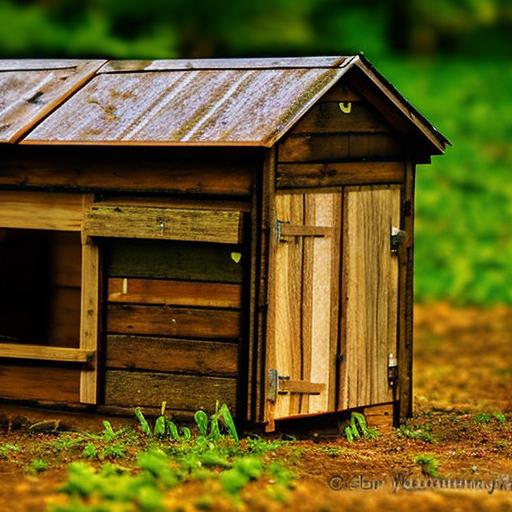As the bitter cold of winter settles in, ensuring the health and well-being of your flock becomes a top priority for any chicken keeper. Properly heating your chicken coop is a delicate balance between providing warmth and preventing potential fire hazards. In this article,we will explore the best practices for safely heating your chicken coop too keep your feathered friends cozy and content during the chilly months ahead.
Table of Contents
Choosing the Right Heating Source for Your Chicken Coop
When it comes to keeping your chickens warm during the colder months, it’s important to choose the right heating source for your coop. One option is to use a heat lamp, which can provide direct warmth to the birds. Though,it’s crucial to ensure that the lamp is securely mounted and positioned in a way that prevents any potential fire hazards. Additionally,consider using a radiant heater,which warms the surrounding air without the need for a light source.
Another alternative is to install a heated panel or mat on the coop floor, providing a more consistent heat source. These panels typically have adjustable thermostats to control the temperature, ensuring that your chickens stay pleasant throughout the winter. Remember, whatever heating source you choose, always monitor the coop temperature regularly to prevent overheating or cold stress in your flock.
Ensuring Proper Ventilation to Prevent Carbon Monoxide Build-Up
When it comes to safely heating a chicken coop, proper ventilation is key. Without adequate airflow, carbon monoxide can build up, posing a serious threat to both you and your chickens. to ensure the safety of your coop, follow these tips:
- Install Ventilation Windows: Consider adding windows to your coop to allow for natural airflow. Make sure they can be opened and closed to regulate the temperature inside.
- Use Exhaust Fans: If natural ventilation is not enough, install exhaust fans to help circulate air and prevent carbon monoxide build-up.
- Monitor Carbon Monoxide Levels: Invest in a carbon monoxide detector to regularly check the levels in your coop. This simple device can save lives.
| Example | Description |
|---|---|
| Window Placement | Windows placed at the top and bottom of the coop can create a natural cross breeze. |
| Exhaust Fan Size | Choose an exhaust fan that is appropriately sized for your coop to effectively remove stale air. |
Implementing Fire Safety Measures in Your Coop
When it comes to safely heating a chicken coop, there are a few important measures to keep in mind. One of the key considerations is to ensure that any heating equipment used is specifically designed for use in a coop and is positioned in a safe location to prevent any fires or accidents. It’s also vital to regularly inspect the heating equipment for any signs of wear and tear, and to replace any faulty parts immediately.
To further enhance fire safety in your coop, consider implementing the following measures:
- Install smoke alarms: Place smoke alarms in and around the coop to alert you in case of a fire.
- keep flammable materials away: Store any flammable materials, such as hay or straw, away from heating equipment.
- Have a fire extinguisher on hand: Make sure to have a fire extinguisher easily accessible in case of emergency.
Monitoring Temperature Levels Regularly for Optimal Comfort
When heating a chicken coop, it is important to monitor temperature levels regularly to ensure the comfort and well-being of your feathered friends. By keeping a close eye on the temperature inside the coop, you can make adjustments as needed to provide optimal conditions for your chickens.
One method to safely heat a chicken coop is to use a heat lamp. Position the heat lamp at a safe distance from any flammable materials and make sure it is securely mounted to prevent any accidents. Additionally,consider using a thermostat to control the temperature and prevent overheating. provide ample bedding for your chickens to snuggle into during colder nights, ensuring they stay warm and cozy. By following these precautions and monitoring temperature levels regularly, you can create a comfortable and safe environment for your feathered friends.
Q&A
Q: Why is it important to safely heat a chicken coop?
A: heating a chicken coop is essential to ensure the well-being and productivity of the flock during colder months.
Q: What are some safe heating options for a chicken coop?
A: Some safe heating options for a chicken coop include heat lamps,heated waterers,and radiant heaters.
Q: What precautions should be taken when heating a chicken coop?
A: Some precautions to take when heating a chicken coop include monitoring temperatures, ensuring proper ventilation, and using fire-resistant materials.
Q: How can I prevent fires when heating a chicken coop?
A: To prevent fires when heating a chicken coop, make sure to regularly inspect heating equipment, keep flammable materials away from heat sources, and never leave heating devices unattended.
Q: Are there any signs that my chickens are too cold?
A: Signs that your chickens might potentially be too cold include huddling together, reduced egg production, and lethargy.
Q: how can I keep my chickens warm without using electricity?
A: You can keep your chickens warm without using electricity by insulating the coop, providing plenty of bedding, and blocking drafts.
Final Thoughts
As you can see,there are several important factors to consider when it comes to safely heating your chicken coop. By following these tips and guidelines, you can ensure that your feathered friends stay warm and comfortable throughout the chilly winter months. Remember to always prioritize safety and be mindful of the potential risks associated with heating devices. With a little bit of planning and preparation, you can create a cozy and inviting space for your chickens to thrive in, no matter the whether. Stay warm, and happy coop heating!
Meet Walter, the feathered-friend fanatic of Florida! Nestled in the sunshine state, Walter struts through life with his feathered companions, clucking his way to happiness. With a coop that’s fancier than a five-star hotel, he’s the Don Juan of the chicken world. When he’s not teaching his hens to do the cha-cha, you’ll find him in a heated debate with his prized rooster, Sir Clucks-a-Lot. Walter’s poultry passion is no yolk; he’s the sunny-side-up guy you never knew you needed in your flock of friends!






